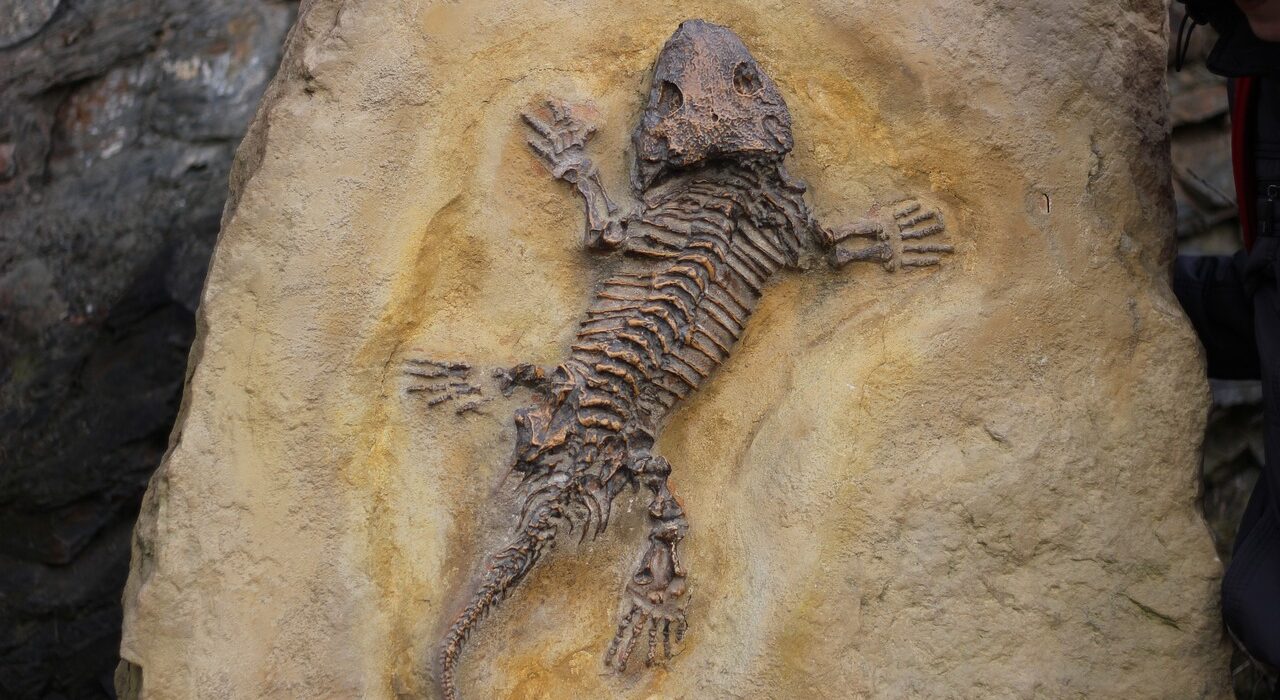Have you ever wondered how scientists can learn about the creatures that roamed the Earth millions of years ago? Fossil evidence is the answer.
Fossils are the remains of once-living organisms that have been preserved in rocks or other materials. These can include bones, teeth, shells, and even footprints. By studying these fossils, scientists can learn about the anatomy, behavior, and ecology of extinct organisms.
But why is fossil evidence so important? Well, for one, it provides a record of how life on Earth has changed over time. By examining the fossils of different organisms from different time periods, scientists can piece together how these creatures evolved and adapted to changing environments. This information can then be used to create a “tree of life,” which shows how all living organisms are related to each other.
Fossil evidence is also crucial for understanding the history of the Earth itself. Fossils can be used to date rocks, which helps scientists determine the ages of different geological formations. This information can be used to reconstruct the geological history of a region and understand how landscapes and environments have changed over time.
In fact, the study of fossils has led to many important discoveries and advancements in our understanding of the natural world. For example, the discovery of the first dinosaur fossils in the 19th century revolutionized our understanding of these incredible creatures and sparked a whole new field of research.
It is a vital tool for understanding the past and present of life on Earth. Through the study of fossils, we can gain a deeper appreciation of the incredible diversity and complexity of the natural world.
Fossil Evidence and Evolution
Fossil evidence is an incredibly valuable tool for studying the process of evolution. By examining the fossils of ancient organisms, scientists can piece together how these creatures evolved over time.
One of the key ways that fossil evidence helps us understand evolution is by providing a record of how different species have changed over time. Fossils can tell us about the size, shape, and structure of ancient organisms, as well as their behaviors and ecological roles. By comparing fossils from different time periods, scientists can see how organisms have evolved over time, adapting to changing environments and developing new traits.
Another important concept in the study of evolution is the “tree of life.” This is a way of representing the relatedness of all species on Earth, showing how different organisms are related to each other through a shared evolutionary history. The tree of life is based on the idea that all living organisms share a common ancestor, and that over time, different groups of organisms have diverged and evolved into new species.
Fossil evidence is a key part of constructing the tree of life. By studying the fossils of ancient organisms, scientists can determine how different species are related to each other and how they fit into the broader picture of evolutionary history. For example, the discovery of early hominid fossils helped us understand how humans evolved from our primate ancestors, and the discovery of feathered dinosaur fossils helped us understand how birds evolved from their dinosaur ancestors.
Fossil evidence provides a wealth of information about the evolution of life on Earth. Through the study of fossils, scientists can gain a deeper understanding of how different species have evolved over time, and how they are related to each other through a shared evolutionary history. It’s a fascinating field of study that continues to yield new discoveries and insights into the natural world.
Fossil Evidence and Geology
In addition to providing insights into the evolution of life on Earth, fossil evidence is also a valuable tool for studying the geological history of our planet. Fossils can be used to date rocks, which helps scientists determine the ages of different geological formations and understand how landscapes and environments have changed over time.
There are several methods used to date fossils and rocks. One common method is radiometric dating, which involves measuring the decay of radioactive isotopes in a sample. This method is based on the fact that certain isotopes of elements, such as uranium and carbon, decay at a predictable rate over time. By measuring the amount of these isotopes in a rock or fossil sample, scientists can calculate its age.
Another method of dating rocks is stratigraphy, which involves studying the layers of rock in a particular area. By examining the sequence of rocks and fossils in different layers, scientists can determine which layers are older and which are younger.
One example of an important geological discovery made through fossil evidence is the discovery of the Chicxulub crater in Mexico. This crater is believed to have been caused by the impact of a massive asteroid, which scientists believe led to the extinction of the dinosaurs. By studying the fossils and rocks in the area, scientists were able to determine the age of the crater and the timing of the mass extinction event.
Fossil evidence has also been used to understand the changing climates and environments of the past. For example, the discovery of fossilized pollen and other plant material in sediments has helped scientists reconstruct past climates and environments, including the ice ages and other major climate events.
In summary, fossil evidence is a valuable tool for studying the geological history of our planet. By dating rocks and fossils, scientists can reconstruct the ages of different geological formations and understand how landscapes and environments have changed over time. Fossil evidence has led to many important discoveries and continues to be an important area of research in geology and paleontology.
Fossilization Process
Fossilization is the process by which organic remains, such as bones or shells, are transformed into fossils over millions of years. The process is complex and requires specific conditions to occur. Typically, fossilization occurs when an organism is buried in sediment or other materials, such as volcanic ash, shortly after it dies. Over time, the organism’s remains are gradually replaced by minerals, preserving its shape and structure.
There are several types of fossils that can be formed through the fossilization process. The most common type is the petrified fossil, which is formed when minerals replace the organic material of an organism’s bones or tissues. Other types of fossils include molds and casts, which are formed when an organism’s remains leave an impression in sediment that is later filled with minerals, and trace fossils, which are formed by the activities of organisms, such as footprints or burrows.
One example of a well-known fossil is the Tyrannosaurus rex skeleton known as “Sue,” which is on display at the Field Museum in Chicago. Sue is a petrified fossil, with her bones replaced by minerals over millions of years. She was discovered in 1990 by a fossil hunter named Sue Hendrickson in South Dakota and was later sold to the Field Museum for $8.36 million.
Another example of a fascinating type of fossil is the Laetoli footprints in Tanzania. These are a series of footprints left by early humans over 3.5 million years ago. The footprints were preserved by volcanic ash and offer insights into the size, shape, and walking patterns of early humans.
The fossilization process is a critical component of understanding the history of life on Earth. By studying fossils and the types of organisms that are preserved, scientists can reconstruct the evolution of life and the changing conditions of the planet over time.
Importance of Fossil Evidence
Fossil evidence is incredibly important because it provides a unique window into the past, allowing us to reconstruct the history of life on Earth. By studying fossils, we can learn about the diversity of organisms that have existed throughout history, how they evolved, and how they interacted with each other and their environment.
One of the most significant contributions of fossil evidence has been the development of the theory of evolution. Fossils provide a record of how organisms have changed over time, allowing us to trace the evolution of different groups of organisms and understand how they are related to each other. This has allowed scientists to construct the “tree of life,” which illustrates the relatedness of all species on Earth.
Fossil evidence has also provided insights into major events in Earth’s history, such as mass extinctions and the evolution of major groups of organisms, such as dinosaurs and mammals. For example, previously mentioned discovery of the Chicxulub crater in Mexico, which was caused by an asteroid impact 66 million years ago, provided evidence that this event was likely responsible for the mass extinction of the dinosaurs and many other groups of organisms.
Ongoing research and discoveries in the field of fossil evidence continue to expand our understanding of the natural world. For example, recent discoveries of early hominin fossils have shed light on the evolution of humans and our closest relatives. Additionally, the discovery of soft tissue preservation in some fossils has allowed scientists to study the biochemical makeup of ancient organisms, providing insights into their physiology and behavior.
Fossil evidence is critical for understanding the history of life on Earth and the processes that have shaped the planet. Ongoing research and discoveries in this field continue to expand our knowledge and provide insights into the natural world. As such, the preservation and study of fossils remains an important area of scientific research.
Conclusion
In conclusion, fossil evidence provides a unique and invaluable window into the past, allowing us to reconstruct the history of life on Earth. Through the study of fossils, we can trace the evolution of different groups of organisms and understand how they are related to each other, providing critical insights into the development of life on our planet.
We have seen how the study of fossil evidence has contributed to major scientific breakthroughs, including the development of the theory of evolution, the identification of mass extinctions and other key events in Earth’s history, and the discovery of new species and lineages. Ongoing research in the field continues to expand our knowledge and understanding of the natural world, providing important insights into the origins of life and the processes that have shaped our planet over time.
In summary, the study of fossil evidence remains a critical area of scientific research, providing us with a window into the distant past and allowing us to better understand the complex and interconnected history of life on Earth. As such, the preservation and study of fossils will continue to be an important area of focus for scientists in the years and decades to come.
Resources
- “Fossil Evidence and Evolution.” Understanding Evolution. UC Berkeley, n.d. Web. 10 Mar. 2022. https://evolution.berkeley.edu/evolibrary/article/0_0_0/evodevo_01
- “Fossils and Geologic Time.” National Park Service. U.S. Department of the Interior, n.d. Web. 10 Mar. 2022. https://www.nps.gov/subjects/fossils/fossils-through-geologic-time.htm
- “Fossilization: A Story of Life and Death.” Understanding Evolution. UC Berkeley, n.d. Web. 10 Mar. 2022. https://evolution.berkeley.edu/evolibrary/article/history_16
- “Why Study Fossils?” Paleontological Research Institution. Paleontological Research Institution and its Museum of the Earth, n.d. Web. 10 Mar. 2022.
- “Dating Rocks and Fossils Using Geologic Methods.” Nature Education Knowledge. Nature Publishing Group, n.d. Web. 10 Mar. 2022. https://www.nature.com/scitable/knowledge/library/dating-rocks-and-fossils-using-geologic-methods-107924044/
- “The Importance of Fossil Record.” Dinosaur Corporation. Dinosaur Corporation, n.d. Web. 10 Mar. 2022.
- “Fossil Evidence.” National Geographic Society. National Geographic Society, n.d. Web. 10 Mar. 2022. https://education.nationalgeographic.org/resource/fossil/
- “Fossilization.” The Virtual Fossil Museum. The Virtual Fossil Museum, n.d. Web. 10 Mar. 2022.


